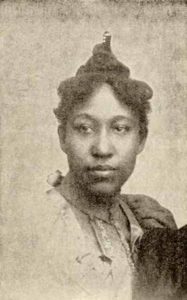
Harriett Marshall
*Harriett Gibbs Marshall was born on this date in 1869. She was a Black concert pianist, author, and educator.
From Vancouver, B.C. Canada, she was the daughter of Marie A. Alexander and Judge Mifflin Wistar Gibbs. She grew up in Oberlin, Ohio, where she became the first Black woman to complete their piano course in 1889. Following graduation and recitals, Gibbs taught music in the public school system in Washington D. C. from1900 from 1903. In her final year, she was the founder of the Washington Conservatory of Music, a school for the "special musical development of the colored American."
On June 3, 1906, she married Napoleon B. Marshall. Her dream was to open a music conservatory for African Americans that would inspire and train Black musicians and encourage them to create and embrace their own heritage of concert music. She also wished to uplift the community by preserving the rich African American musical heritage and increasing Black audiences' exposure to professional musical performances and other cultural events.
Under her management, and in later years, under that of her cousin, Victoria Muse, the Conservatory represented the nation’s most successful Black-owned. It operated a music school to have advocated the study and performance of Black music. Throughout its 57-year existence, the school’s highly trained faculty brought in talented students from all over the United States and produced leaders in the field from among its graduates. Throughout its existence, and especially in the early years, the Conservatory faculty encouraged the desire for music in the Washington, D.C., community by sponsoring annual concerts featuring nationally famous Black musicians and other cultural events.
The establishment of the Conservatory was only part of Harriet Gibbs Marshall’s dream. She envisioned a National Negro Music Center, at which the Conservatory would be the facility used for teaching. The aim of the Center, which opened in 1936, was to foster research and preservation of the rich musical heritage of Black America. The actual scope of the Center fell short of her dreams because of insufficient funding. It did become a storehouse for published works by African American composers. Thousands of pieces of sheet music of Black composers were collected and preserved under Marshall’s direction, thus fulfilling part of her dream of creating a historical reserve for Black music research.
As a writer, she published A Story of Haiti 1930, followed by Last Concerto, based on the life, love, and music of Samuel Coleridge-Taylor. Harriett Gibbs Marshall died on February 25, 1941.
The African American Atlas
Black History & Culture an Illustrated Reference
by Molefi K. Asante and Mark T. Mattson
Macmillan USA, Simon & Schuster, New York
ISBN 0-02-864984-2